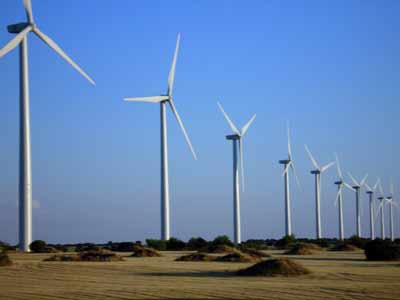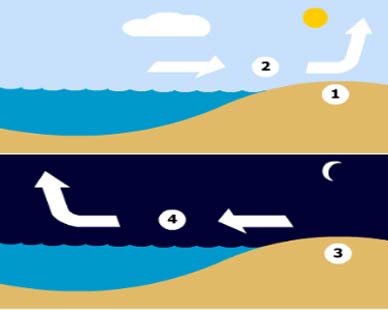|
What Is Wind?
We all know what wind is... right? At least we all know what wind "feels" like - but what is wind? Where does it come from? What causes wind? In reality, wind is a form of solar energy. The sun heats the earth at different rates. Different surfaces (for example, water and land) absorb or reflect heat at different rates. This in turn causes the air in our atmosphere to warm differently over the varied surfaces.
Hot air rises, reducing the atmospheric pressure at the earth's surface, and cooler air is drawn in to replace it. The result of this change in pressure, combined with the rotation of the earth, is wind. So why does the pressure vary from place to place and from day to day? There are two main reasons: 1) The rotation of the earth As the earth spins on its axis it pulls the atmosphere around with it. The air higher up in the atmosphere is less affected by this pulling effect. The difference in the air speed at different heights in the atmosphere causes the air to mix, forming turbulence, which causes wind from high in the atmosphere, right down to the earth's surface. The rotation of the earth causes another related phenomenon, the Coriolis force.This occurs when air is moving over the surface of the earth as it rotates. Instead of traveling in a straight line, the path of the moving air veers to the right. So instead of the air (or wind) moving in a straight line from areas of higher pressure to areas of lower pressure, it moves almost parallel to the isobars. The result is that the wind circles towards the area of low pressure. In the Southern hemisphere, the wind will circle in an anti-clockwise direction and clockwise in the Northern hemisphere. ------------------------------- SIDEBAR: ISOBARS EXPLAINED ------------------------------- If you have seen a weather forecast on TV, you have likely seen a map showing atmospheric pressure (the map with lines on it). This is referred to as an isobar chart. Isobars are similar to contour lines except instead of showing the height of the ground, the lines on an isobar map show areas where the atmospheric pressure is the same. The closer the lines are together the more rapidly the pressure changes from one area to another. ------------------------------- 2) The heating effect of the sun The effect of the sun varies with latitude, and with the time of day. Warmer air is less dense than cooler air, and hence rises above it. As such, the pressure above the equator is lower than the pressure above the poles. The effect is greater over the equator because the sun is directly overhead. As you move towards earth's poles, the angle at which the suns rays hit the earth is more acute, so the same amount of energy is spread over a larger area. There are also local effects which contribute to wind.
The picture above shows the wind patterns of coastal regions. Land heats up and cools down more quickly than the sea. 1. During the day the air above the land warms, becomes less dense and rises in the atmosphere. 2. The atmospheric pressure above the land drops and air from the sea moves in. This creates a sea breeze. 3. During the night, the temperature of land drops much faster than that of the sea. 4. The air above the sea in therefore hotter than the air above the land so he effect reverses. In summary to the question "what is wind?" It is moving air caused by differences in air pressure within our atmosphere, combined with the movement of the earth. Air under high pressure moves toward areas of low pressure. The greater the difference in pressure, the faster the air flows. The faster the air flows - the harder the wind blows! I hope that answers the question of "what is wind?" |







